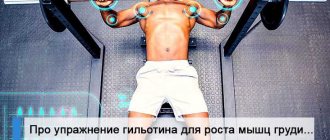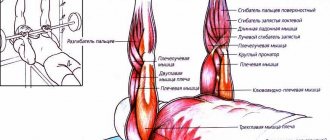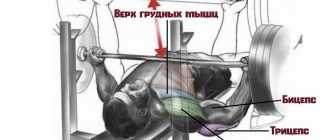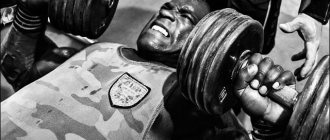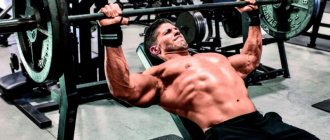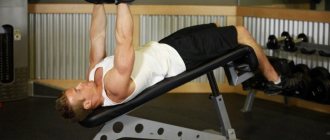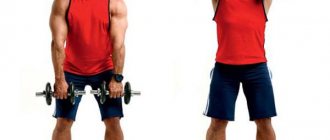Pros and cons of deadlifts with emphasis on the bench
Pros:
- The great advantage of this basic exercise is that the athlete’s spine and body position are securely fixed.
- The athlete can also perform the movement with different grips and adjust the inclination when performing the exercise. Tilt allows you to change the emphasis from one part of the back to another.
- The exercise effectively affects the back muscles.
- Relevant for both men and women.
- It can be performed by early-age athletes, since when performing the lying row there is no axial (any) load on the spine.
- This exercise allows you to work with heavy weights.
- Excellent for those athletes who have problems with the lumbar spine.
Minuses:
- The exercise is inferior in comfort and convenience to such specially created structures for working the back muscles, such as a lever bar or a T-bar. In fact, after introducing the bench row into the training process, the athlete quickly gets used to it.
- Also, when the back of the bench is positioned horizontally, the range of motion is short.
2 more varieties of this movement
In addition to the classic variation, there are 2 more common options for performing this movement.
One-arm dumbbell row
Performing the exercise while leaning on a bench is the most popular. This type perfectly works all the back muscles, relieves stress from the lower back, and allows you to get noticeable results quite quickly, provided that the technique is strictly followed.
- Place your knee on a horizontal bench. With the same hand we place emphasis. We hold the dumbbell with the opposite hand extended towards the floor. We keep the opposite leg straight and move it back a little, resting on the floor.
- The torso is parallel to the floor. We pull the dumbbell in the same way as in the classic version.
- The maximum position of the dumbbell is bench level. When performing the movement, the body is strictly fixed . Slowly lower the dumbbell, extending your arm. We don't touch the floor. We repeat the exercise, focusing on the back muscles.
2nd method of execution
- We rest our hand on the bench.
- Both legs are behind the bench with the knee slightly bent.
- One leg is placed slightly forward to create a more stable position.
- Otherwise, we repeat the classic version, as indicated above.
For detailed techniques, watch the video:
In both cases, we primarily load the following muscles:
- Diamond backs;
- Latissimus dorsi;
- External oblique abdomen;
- Gluteal – small, medium, large;
- Biceps;
- Rear deltoids;
- Trapezoidal.
Lying on your stomach
We perform this movement while lying on an inclined bench. We set the tilt angle for the backrest to about thirty degrees.
- We lie on our stomachs, arms hanging down.
- The chin is slightly higher than the back. Dumbbells are on the floor parallel to the shoulders.
- We spread our legs and rest our toes on the floor. We check the stability of the position.
- When performing the exercise, only the arms are bent at the elbow joints.
Dumbbell rows lying on your stomach contribute to the formation of a muscle corset and the prevention of spinal diseases; it is very useful not only for men, but also for women.
Learn more from the video:
This is interesting! This exercise is popular due to the fact that it does not place a traumatic load on the lumbar spine, and in general does not provoke back injuries. At the same time, we work the same muscles as in the classic deadlift.
Wide grip barbell row
This exercise is performed on a horizontal bench or in an inclined position with emphasis on the bench.
What muscles work
- The emphasis of the load falls on the latissimus dorsi muscles.
- When performing a bending exercise, the emphasis shifts to the upper back, namely the round muscles and even the posterior deltoid muscles.
Execution technique
- Before performing the exercise, you need to place the barbell under the bench at the level of the pectoral muscles.
- The athlete should take a face-down position, gripping the bar wider than shoulder-width apart.
- Traction, upward movement, is carried out due to the work of the back muscles. The arm muscles should not be involved in the work. The weight rises as you exhale.
- At the top point of the amplitude it is necessary to make a short delay.
- In this exercise, it is better to use a curved bar, as it will give you a greater range of motion.
- As you exhale, you need to slowly lower the bar.
Bent-over barbell row video
To better understand how to do bent-over barbell rows, watch the video in which Alexey Klakotsky performs this exercise with a barbell weighing 145 kg for 8 repetitions. What a strength!
Conclusion
The bent-over barbell row perfectly works the entire muscle mass of the back, increasing its thickness and width. Be sure to include this exercise in your training program. Before lifting huge barbells, learn the movement technique and feel how your lats work. Increase the weights gradually and make sure that the load does not go to your arms. May your back be broad!
Get better and stronger with bodytrain.ru
Read other articles in the blog's knowledge base.
Barbell row with a narrow grip to the waist while lying on a bench
Rows with this grip can be performed on a bench installed at an incline or horizontally.
What muscles work
This version of the exercise is aimed at training the latissimus and central back muscles. These are the rhomboid muscles and the trapezius muscle. The teres major muscles are also involved in the work.
Execution technique
There is no difference in performing rows with a narrow and wide grip on a bench. The only thing worth mentioning is the grip. Hands on the bar should be placed at shoulder level, and should be pulled towards the waist.
Parallel grip dumbbell row lying on a bench
This exercise is similar to the deadlift in a lever machine. You can also perform a similar exercise with dumbbells while standing, but rowing while lying on a bench is a safer option and allows athletes who have problems with the lumbar spine to work. Read more about dumbbell rows →
What muscles work
During rowing, the latissimus dorsi muscles work. Their work is supplemented by the teres major muscles. Also, a small part of the load falls on the posterior deltoid muscles, rhomboid muscles and trapezius muscle.
Execution technique
The principle of operation does not change in this version of traction. When pulling to the waist, the dumbbells move along the bench.
Technique for performing classic standing deadlifts (video)
The two dumbbell bent over row is the exercise you should always start your workout with. We perform the movement slowly, smoothly, without jerking. We breathe freely, we cannot hold our breath . Exhale - tension, inhale - relaxation! We control our breathing until we do it automatically. If you breathe incorrectly, performing this movement will cause harm instead of benefit.
- Take dumbbells and bend forward until a right angle is formed in the hip joints. We place our feet shoulder-width apart and slightly bend our knees. Keep your back straight, without bending.
- We lower the dumbbells onto outstretched arms and begin to pull them towards the stomach, bringing the shoulder blades together. We lift dumbbells using the force of bringing the shoulder blades together, not the elbows.
- At the maximum point we pause and return to the starting position.
- We focus on the back muscles. A slight burning sensation indicates that the muscle is starting to work.
- We return to the starting position.
It is better to choose the number of approaches and the weight of dumbbells individually with the help of an instructor. On average, this is three sets of twelve exercises. Incorrectly selected dumbbell weights can lead to injury .
For detailed techniques for girls and women, watch the video:
What does a reverse grip affect?
We take dumbbells with a reverse grip when we need to thoroughly work the middle and lower back muscles. This grip gives us the opportunity to concentrate the main load on the latissimus dorsi muscles, giving them volume, relief and strength.
- We take the dumbbells with our palms forward and bend until a right angle is formed at the hip joints. We place our feet shoulder-width apart and slightly bend our knees. Keep your back parallel to the floor.
- We lower the dumbbells onto outstretched arms and begin to pull them towards the stomach, bringing the shoulder blades together, moving the elbows towards the body and placing them behind the back. We lift the dumbbells due to the strong contraction of the shoulder blades. Having felt the maximum tension, we return to the starting position.
This is interesting! This movement is the most common variation of the classic exercise.
This variation is quite complex, it is more suitable for men and is performed not only with dumbbells, but also with a barbell.
Recommendations for implementation in training
- The prone row is a basic strength exercise that is best included in your workout as an additional exercise.
- The best option would be to perform the exercise after pull-ups and lat pull-downs.
- The training scheme for building muscle is simple: 3-4 sets of 8-12 repetitions.
- The exercise can be included in a superset with antagonist muscles, for example, incline dumbbell press + bench row.
- The exercise is perfect for women too. For women's training, the number of approaches will not have to be changed, but the repetitions will be 15-20.
- If the exercise is performed as part of a weight loss workout, the number of repetitions can be increased to twenty-five.
Nuances
It is important not to lift your chest off the bench. Otherwise, emphasis is lost, and the load on other parts of the body increases. This leads to injury and makes the technique less effective.
It is also important to understand that the load on the chest should not be extreme. Otherwise, injury may also occur. In order not to overload the chest, it is better to avoid the maximum weight.
To perform the exercise correctly, it is important to keep your elbows close to your body. In this situation, the shoulder muscles work less. If it is difficult to hold sports equipment in your hands, you can use straps. If in this case the technique is difficult, it is better to stop the exercise and do something easier. Then, when the body is ready, it is possible to return to the method.
There are variations of the technique. There are two of them. In one case, the same thing is done, but the bench is located horizontally to the floor. In such a situation, there is a chance to better work the rhomboid muscles on the back. However, to do this you will have to squeeze your shoulder blades together.
However, this option will not be feasible for everyone. Unlike incline rows, the load shifts upward because the body position is horizontal. The back muscles work poorly, because the amplitude is shortened.
Another option is a reverse grip. The difference with the classic method is that the biceps play a big role. The amplitude is greater. It is more convenient to lift the barbell from the floor. There is no fundamental difference. If during such an exercise your hands suddenly become sore, this is an alarming sign, and you should consult a doctor and stop training for a while.
If the instructor says that in all respects a person is ready for such a deadlift, but there is pain, discomfort, or simply cannot be performed, this is a reason to worry. Perhaps the fact is that some kind of injury occurred that went unnoticed. It's worth seeing a doctor.
What can be replaced
This method is a basic method, so it can easily be replaced with other exercises. However, if your health and fitness permit, you should not bypass the lying row, because the technique has proven itself to be excellent.
If for some reason this is not suitable, here is what to replace this craving with:
- Bent-over barbell row.
- Push-ups on parallel bars with the body tilted forward. The grip is wide.
- Pull a dumbbell to the stomach with one hand, resting with the other. The person stands at an angle.
- For the latissimus dorsi muscle - traction of vertical and horizontal blocks.
Like bench rows, these exercises require the person to already be fairly prepared. If you had to do office work for twenty years and had no energy left for gymnastics, you can’t start with these kinds of methods.
To begin with, it is worth tidying up the muscles of the whole body, strengthening them and making sure that the cardiovascular system is strong enough and healthy.
If a person suffered an illness, even many years ago, it is better to take this circumstance into account. Some diseases, in principle, are not conducive to heavy physical activity.
That is why in such a situation it is better to consult a doctor first. Then there will be no complications from this or any other technique associated with efforts that are not typical for a person in everyday life.


